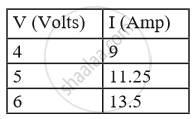Advertisements
Advertisements
प्रश्न
Two bulbs are marked 100 W, 220 V and 60 W, 110 V. Calculate the ratio of their resistances.
उत्तर
Given Ist Bulb
P1 = 100 W
V1 = 220 V
IInd Bulb
P2 = 60 W
V2 = 110V
We know P = `"V"^2/"R"`
So R = `"V"^2/"P"`
So `"R"_1/"R"_2 = ("V"_1^2/"P"_1)/("V"_2^2/"P"_2)`
`= ("V"_1^2 xx "P"_2)/("P"_1 xx "V"_2^2)`
`= (220^2 xx 60)/(100 xx 110 xx 110) = 2.4`
APPEARS IN
संबंधित प्रश्न
How much energy is given to each coulomb of charge passing through a 6 V battery?
What is the SI unit of potential difference?
Define one coulomb charge.
Explain the statement ‘the potential difference between two points is 1 volt’.
Define the term ‘volt’.
The following table shows current in Amperes and potential difference in Volts.
What will be the nature of the graph between the current and potential difference? (Do not draw a graph.)

From the following observations taken while determining the resistance of a conductor, draw the current-voltage graph and calculate the resistance of conductor. Is the conductor ohmic?
| Ammeter reading I (in ampere) | Voltmeter reading V (in volt) |
| 0.2 | 0.4 |
| 0.3 | 0.6 |
| 0.5 | 1.0 |
| 0.8 | 1.6 |
| 1.5 | 3.0 |
Conceptual question.
A bird sitting on a high power electric line is still safe. How?
How will you conclude that the same potential difference (voltage) exists across three resistors connected in a parallel arrangement to a battery?
Inside a hollow charged spherical conductor, the potential ______
